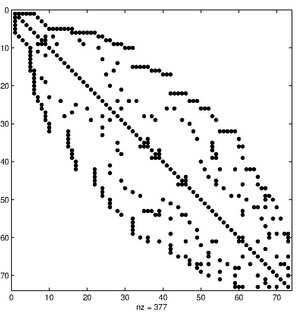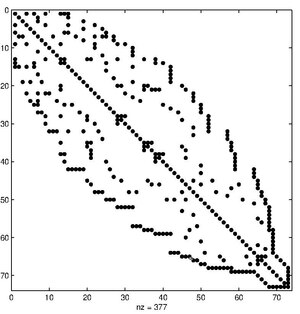Dirac measure


In the mathematical subfield of matrix theory, the Cuthill–McKee algorithm (CM), named for Elizabeth Cuthill and J. McKee ,[1] is an algorithm to permute a sparse matrix that has a symmetric sparsity pattern into a band matrix form with a small bandwidth. The reverse Cuthill–McKee algorithm (RCM) due to Alan George is the same algorithm but with the resulting index numbers reversed. In practice this generally results in less fill-in than the CM ordering when Gaussian elimination is applied.[2]
The Cuthill McKee algorithm is a variant of the standard breadth-first search algorithm used in graph algorithms. It starts with a peripheral node and then generates levels for until all nodes are exhausted. The set is created from set by listing all vertices adjacent to all nodes in . These nodes are listed in increasing degree. This last detail is the only difference with the breadth-first search algorithm.
Algorithm
Given a symmetric matrix we visualize the matrix as the adjacency matrix of a graph. The Cuthill–McKee algorithm is then a relabeling of the vertices of the graph to reduce the bandwidth of the adjacency matrix.
The algorithm produces an ordered n-tuple R of vertices which is the new order of the vertices.
First we choose a peripheral vertex (the vertex with the lowest degree) x and set R := ({x}).
Then for we iterate the following steps while |R| < n
- Construct the adjacency set of (with the i-th component of R) and exclude the vertices we already have in R
- Sort with ascending vertex order (vertex degree).
- Append to the Result set R.
In other words, number the vertices according to a particular breadth-first traversal where neighboring vertices are visited in order from lowest to highest vertex order.
See also
References
- ↑ E. Cuthill and J. McKee. Reducing the bandwidth of sparse symmetric matrices In Proc. 24th Nat. Conf. ACM, pages 157–172, 1969.
- ↑ J. A. George and J. W-H. Liu, Computer Solution of Large Sparse Positive Definite Systems, Prentice-Hall, 1981
- Cuthill–McKee documentation for the Boost C++ Libraries.
- A detailed description of the Cuthill–McKee algorithm.
- symrcm MATLAB's implementation of RCM.






